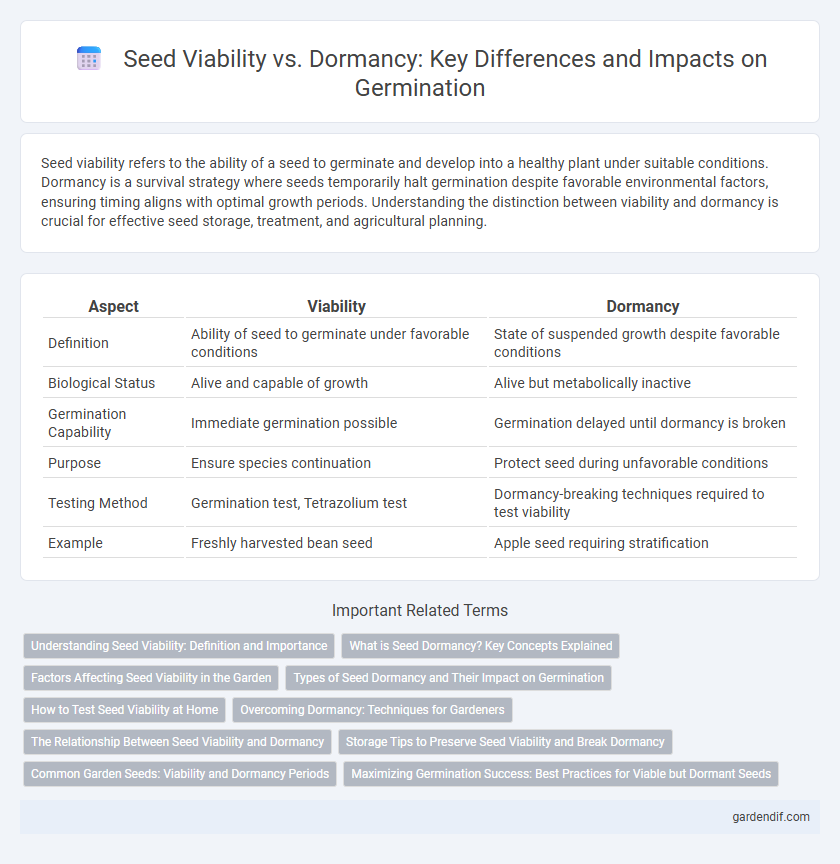
Viability vs Dormancy Illustration
Seed viability refers to the ability of a seed to germinate and develop into a healthy plant under suitable conditions. Dormancy is a survival strategy where seeds temporarily halt germination despite favorable environmental factors, ensuring timing aligns with optimal growth periods. Understanding the distinction between viability and dormancy is crucial for effective seed storage, treatment, and agricultural planning.
Table of Comparison
| Aspect | Viability | Dormancy |
|---|---|---|
| Definition | Ability of seed to germinate under favorable conditions | State of suspended growth despite favorable conditions |
| Biological Status | Alive and capable of growth | Alive but metabolically inactive |
| Germination Capability | Immediate germination possible | Germination delayed until dormancy is broken |
| Purpose | Ensure species continuation | Protect seed during unfavorable conditions |
| Testing Method | Germination test, Tetrazolium test | Dormancy-breaking techniques required to test viability |
| Example | Freshly harvested bean seed | Apple seed requiring stratification |
Understanding Seed Viability: Definition and Importance
Seed viability refers to the ability of a seed to germinate and develop into a healthy plant under suitable conditions, which is crucial for successful crop production and biodiversity conservation. Understanding seed viability helps determine the optimal storage duration and conditions, ensuring maximum germination rates and seedling vigor. Dormancy, a state where seeds temporarily fail to germinate despite favorable conditions, differs from viability and requires specific methods to break dormancy without compromising seed health.
What is Seed Dormancy? Key Concepts Explained
Seed dormancy is a survival mechanism preventing germination under unfavorable conditions, ensuring seeds remain viable until the environment supports growth. It involves physiological, morphological, or physical inhibitors that delay sprouting despite the presence of water and suitable temperatures. Understanding dormancy is crucial for agriculture and horticulture, as breaking dormancy through methods like stratification or scarification promotes uniform germination and crop yield.
Factors Affecting Seed Viability in the Garden
Seed viability in the garden is influenced by factors such as moisture levels, temperature, and seed age, which directly impact the seed's ability to germinate. Proper storage conditions with low humidity and stable, cool temperatures help maintain seed viability over time. Exposure to pests, diseases, and physical damage can reduce seed viability, while some seeds enter dormancy, requiring specific environmental triggers to resume germination.
Types of Seed Dormancy and Their Impact on Germination
Seed dormancy types, including physical, physiological, morphological, and combinational dormancy, play a crucial role in regulating germination timing and success. Physical dormancy involves seed coat impermeability, while physiological dormancy results from internal chemical inhibitors that prevent embryo growth. Understanding these dormancy mechanisms aids in optimizing seed viability assessments and improving germination strategies in agriculture and conservation.
How to Test Seed Viability at Home
Testing seed viability at home involves a simple water soak test where seeds are placed in a container of water for 24 hours; viable seeds typically sink while non-viable ones float. Another effective method is the paper towel test, which requires wrapping seeds in a moist paper towel, storing them in a warm place, and checking for germination within 7-10 days. These techniques help distinguish between dormant seeds, which may not germinate immediately, and non-viable seeds that will not sprout.
Overcoming Dormancy: Techniques for Gardeners
Overcoming seed dormancy involves techniques such as scarification, stratification, and soaking to enhance germination rates and seed viability. Scarification breaks the hard seed coat, stratification mimics natural cold periods, and soaking softens seeds and speeds up moisture absorption. Gardeners applying these methods can significantly improve seed sprouting success and overall plant establishment.
The Relationship Between Seed Viability and Dormancy
Seed viability refers to the ability of a seed to germinate and develop into a healthy plant under suitable conditions, while dormancy is a temporary state in which seeds delay germination despite favorable environmental factors. The relationship between seed viability and dormancy is crucial, as viable seeds may remain dormant to survive adverse conditions, ensuring species persistence and optimal timing for growth. Understanding this interplay aids in improving seed storage methods, agricultural planning, and restoration ecology by predicting germination patterns and enhancing crop yield.
Storage Tips to Preserve Seed Viability and Break Dormancy
Proper seed storage involves keeping seeds in cool, dry, and dark conditions to maintain viability over time. To break seed dormancy, techniques such as stratification, scarification, or soaking can be applied based on seed type and physiological requirements. Monitoring humidity levels below 50% and temperatures between 32-41degF (0-5degC) significantly enhances seed longevity and germination success.
Common Garden Seeds: Viability and Dormancy Periods
Common garden seeds exhibit varying viability and dormancy periods critical for successful germination and crop yield. Viability refers to the seed's capacity to germinate under favorable conditions, often lasting from one to five years depending on species and storage environment. Dormancy periods, which can range from weeks to months, prevent premature germination by requiring specific triggers such as temperature fluctuations or light exposure to break dormancy and initiate growth.
Maximizing Germination Success: Best Practices for Viable but Dormant Seeds
Viable but dormant seeds require specific treatments to break dormancy and maximize germination success, such as stratification, scarification, or chemical treatments tailored to the seed species. Maintaining optimal temperature, moisture levels, and oxygen availability ensures the seed's metabolic activation without compromising viability. Understanding species-specific dormancy mechanisms and implementing precise pre-germination protocols significantly improves seedling emergence and overall crop yield.
Viability vs Dormancy Infographic

 gardendif.com
gardendif.com